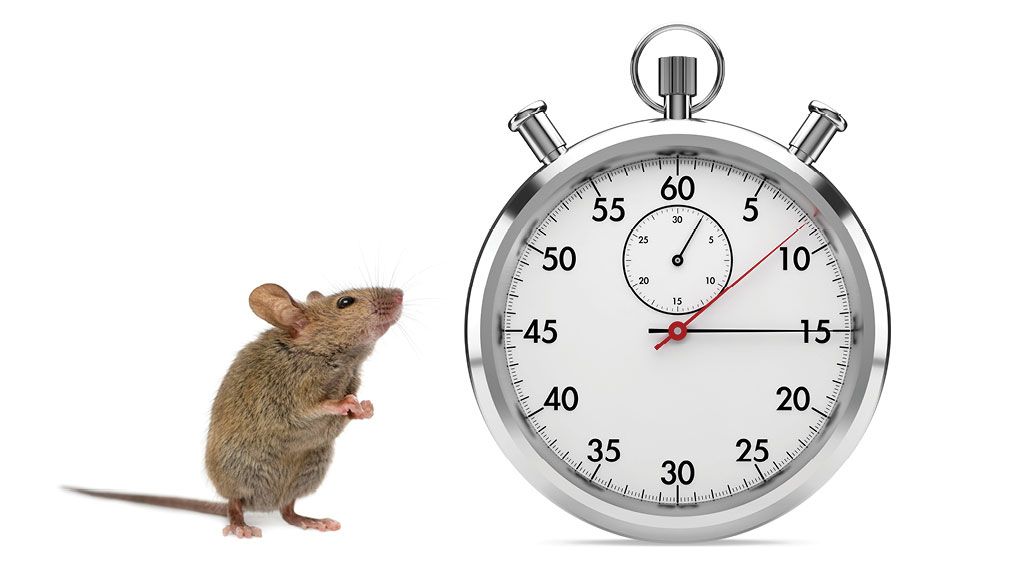A mouse’s metabolism may follow circadian rhythms set by gut bacteria
The microbes control when fat gets absorbed from food, a study finds

Bacteria in the small intestine of mice may set the clock on the animals’ metabolic rhythms.
Mouse: GlobalP/iStock/Getty Images Plus; Watch: alikemalkarasu/E+/Getty Images
- More than 2 years ago
Mice (and maybe people) may metabolize food according to daily, circadian rhythms set by gut bacteria.
Microbes in the small intestine of mice rhythmically dictate when fat is taken up by cells that line the organ, researchers report. The study, described in the Sept. 27 Science, details how gut microbes influence a host’s metabolism. If the findings carry over to people, the research may give clues to why jet lag and night-shift work, which can throw off circadian rhythms, often lead to obesity, diabetes and other health problems.
Researchers knew that human cells have molecular clocks that time 24-hour circadian cycles of metabolism (SN: 11/8/18), and that gut microbes in the colon follow their hosts’ biological beat (SN: 10/16/14). But the new study finds that, at least in the small intestine, microbes can set rhythms for host cells to follow. That work was done in mice, but the process may work similarly in people.
The new research “is helping us appreciate just how intertwined are the metabolisms of the microbiota and their mammalian hosts,” says microbiologist and immunologist Andrew Gewirtz of Georgia State University in Atlanta who was not involved in the work. “It’s a very intimate interaction, regulating things as basic as circadian rhythms, which was quite a surprise.”
Previous research has found that mice raised without any microbes don’t gain excess weight, even when fed a high-fat diet. Those “germ-free mice” also lacked strong circadian rhythms in cells lining the rodents’ small intestines, microbiologist Lora Hooper of the University of Texas Southwestern Medical Center in Dallas and colleagues found. Giving the mice intestinal bacteria, however, strengthened those circadian rhythms. It’s unclear which microbes are important for this process.
Microbes’ key to setting the metabolic beat turns out to be a protein called histone deacetylase 3, or HDAC3. Mice lacking that protein from cells lining the small intestine also don’t gain weight on a junk food diet, the researchers discovered. Those findings suggested a link between gut microbes and HDAC3.
HDAC3 helps regulate when genes are turned on and off by stripping molecules called acetyl groups from histone proteins. Histones form spools around which DNA is wound in cells. Adding (or removing) acetyl groups or other molecules — often called epigenetic marks — to the histones influences how tightly DNA spools. More tightly wound DNA is less accessible to proteins that turn on genes. In mice with intestinal bacteria, histone acetylation marks cycled in a daily rhythm. But germ-free mice lack robust cycling, suggesting that microbes control host cells’ circadian rhythms by timing HDAC3’s activity.
Hooper’s lab also uncovered a new role for HDAC3 that doesn’t involve plucking acetyl groups off histones. The protein rhythmically interacts with another protein called estrogen-related receptor alpha, or ERRalpha, to turn on a gene involved in fat absorption. That gene, Cd36, produces a fatty acid transport protein that allows cells lining the small intestine to take up fats (SN: 7/25/19).
Hooper and colleagues don’t yet know the details of how microbes govern when HDAC3 will get together with other proteins to control gene activity. For instance, microbes might be producing proteins or small molecules that govern HDAC3 activity. Or maybe coming into contact with gut microbes triggers intestinal cells to spur HDAC3 into action.
“This was such an enormously complicated system that we couldn’t possibly nail everything down,” Hooper says.
What’s clear is that the bacteria are necessary to engage the circadian clock with metabolic machinery, says Satchidananda Panda, a circadian biologist at the Salk Institute for Biological Studies in La Jolla, Calif. He likens the circadian clock in intestinal cells to a car idling at a stoplight. The engine is running, but the wheels aren’t turning. Bacteria somehow engage the transmission — HDAC3 — to interact with the clock and schedule activities, such as fat absorption.
If the process also happens in people, disrupting microbes’ circadian rhythms by traveling to faraway places or working irregular schedules may also throw off metabolism, causing people to extract more fat from the food than usual and gain weight. Future research into how gut microbes influence their hosts’ circadian clocks may lead eventually to the development of drugs to counteract the negative health effects of jet lag and shift work, Panda says.







